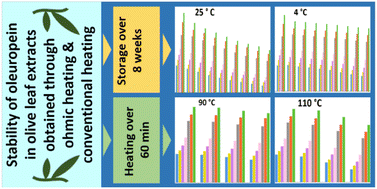Effect of storage, temperature, and pH on the preservation of the oleuropein content of olive leaf extracts
Abstract
Oleuropein, upon sucessful extraction from olive leaves, is treasured as being one of the major bioactive compounds with great potential for being incorporated into numerous food formulations that are processed under specific surrounding conditions. In this regard, for oleuropein to sustainably exert bio-functional effects, it needs to remain potent in an adequate amount in every step of potential valorizations. That being the case, this study examined the stability of olive leaf extracts obtained through ohmic heating (OH) compared to the conventional heating, (Conven) in terms of the total phenolic content (TPC), oleuropein (the key dependent variable), and hydroxytyrosol. The extracts were subjected to different surrounding conditions: (i) storage temperatures of 25 °C, 4 °C, and −20 °C over different time points for eight weeks; (ii) heating at 70 °C, 90 °C, and 110 °C over different time points (min), and (iii) pH ranging from 3 to 9. The results from storage stability tests revealed that a storage temperature of −20 °C was the optimal condition for the stability of the extracts, while storage at 25 °C was the least desirable condition, particularly for oleuropein and TPC. The thermal study showed that exceeding a high temperature (particularly 110 °C) was detrimental to the oleuropein content. Also, the optimum pH value (pH 5) determined in this study narrowly resembled the pH values observed at the initial point of the extracts (4.8–5.2). Importantly, the data support the preference of ohmic heating over a conventional heating approach because substantial quantities of polyphenols remained in the OH extracts over the course of storage/heating. For oleuropein, ohmic heating at 75 °C was the most preferred approach, whereby the values continued to stay at the highest levels in the varying surrounding conditions/over different time points.



 Please wait while we load your content...
Please wait while we load your content...